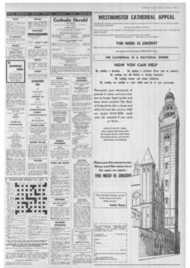Page 3, 31st December 1971
Page 3

Report an error
Noticed an error on this page?If you've noticed an error in this article please click here to report it.
Tags
Share
Related articles
Fleet Street's Holier Side
St Simon Stock And Simon Of Mount Carmel
In A Spiritual Line From Aylesford
Misprints In The Sands Of Time
Confusion Over The Carmelites
Last link with Whitefriars is broken
by BRoCARD SEWELL, 0.Carm. THIS week, the Ceititner I tateip leaves its present address. For the last 33 years its offices have been within the limits of the medieval Whitefriars, the Carmelite monastery on the banks of the Thames, close to Fleet Street. It was a stadium generale of the Order, and seems to have housed, on the average. about one hundred students, with an appropriate number of professors.
The precincts covered a large area, within" which were private dwellinghouses of considerable size. The founder of the priory was that same Lord Grey of Codnor who also founded the Carmelite house at Aylesford.
This latter represented to begin with the Order's original strictly eremitical and contemplative tradition; the house of studies off Fleet Street represented from the first the Order's newly modified vocation as "Mendicants." It was famous for its fine library; among its better known members, at one time or another, were Thomas Netter of Walden, the great theologian; Robert Mascall, confessor to Henry IV and subsequently bishop of Meath; and Richard Maidstone, the poet,
In his Introduction to The Complete Works of 7-homas Shari-well, Montague Summers says that the London Whitefriars "was regarded as a place of especial sanctity, and enjoyed peculiar privileges. Even when the monastery was suppressed at the dissolution, the traditional privileges remained, and the consequence was that this quarter became a refuge for rogues and masterless men, and for all persons who for any reason were desirous of escaping from justice.
It was here, if anywhere, that arrests could be successfully evaded, and naturally before lung the whole district became one of notorious ill repute.
Before 1623 the whole Whitefriars area had acquired the cant name of 'Alsatia'. This dubious district, with its privilege of 'sanctuary' (abolished only in 1697) has been immortalised. in Shadwell's comedy The Squire of Alsatia and Scott's novel 7-he Fortunes of Nigel.
NOSTALGIA
The former presence of the Carmelites here is commemorated today by the name of Whitefriars Street; but the only trace of the former priory that survives is a small crypt below the offices of The News of the World. Carmelite House also is named after them; but this edifice perhaps reminds us more vividly of the late Lord Northcliffe and his unwilling henchman Arthur Machcn than it does of the former brethren.
The latter-day Carmelite must surely experience a certain nostalgia when he passes near or through the limits of the former London Whitefriars; a nostalgia until now to some extent assuaged by a living Catholic presence there: that of the CATHOLIC HERALD. With the HERAI 17) about to move to other quarters, a walk through Alsatia will soon have an added sadness.
These are hard times for religious orders and religious newspapers alike. Recruits to the Carmelite Order are at present far from numerous, an this situation seems unlikely to change much. The Order must act fast and wisely if it is to survive.
Recently a group of younger secular priests was quoted as saying that they did not read the Catholic press. as they felt it to be too narrow and provincial. This too seems to indicate a state of affairs that calls for desperlt emedies.
The Carmelite Order needs strong leadership and thoughtful re-orientation if it is to continue to have any effect at all in the modern world. Its General Chapter meets in September. and its programme will be arduous. For the moment. let us confine ourselves to the state of the Order in England.
FAVERSHAM In its palmy days it numbered sonic 1.500 brethren; by the beginning of the 16th century, however, this figure had dropped to 600; and at the Dissolution in 1538 there were not more than 280 friars, distributed among some thirty-nine houses.
The collapse of the Order in this country at the Reformation was total. A few fathers, mostly French and Irish. attempted to re-establish the Order in London under James II; but their efforts came to nothing. An attempt by Dutch and Irish farmers to establish a mission in Merthyr Tydfil struggled on faint 1864-1879, and then petered out.
In 1926 the Irish Province made a small foundation at Faversham. in Kent; this time the attempt was successful, It culminated three years ago in the official re-establishment of the English Carmelite Province, now more correctly described as Anglo-Welsh.
After forty-five years of revived Carmelite life, what is the position of the Order in Britain today? In some respects the position is disappointing; in spite of all the Aylesford rhlame the Province's membership remains very small. There are now few students and novices; but this is a situation common to all, or almost 411. religious orders, and it need not be considered irremediable if those chiefly concerned can break out of ways of thinking and acting that are no longer relevant, and can forget some of their preoccupations with canon law.
OPPORTUNITY
The Anglo-Welsh Carmelite Province has now nine houses. Of these five are in Kent (diocese of Southwark); viz., Ayles
ford, Allington Castle. Faversham, Hartley, Sittingbourne. Two are in Wales (diocese of Menevia): Aberystwyth and Lampeter. Dm is at Cheltenham (diocese of Clifton) and one. Tadcaster, in Yorkshire td.locese of Leeds).
Resident in these houses are some fifty brethren, of whom about thirty-two are in priest's orders.
The first thing that strikes one on examining these nine houses is that after forty-five years the English Carmelite Province has not yet succeeded in establishing anything that can be shown or recognised as a 'typical' Carmelite house. Six of these houses are in fact clergy houses attached to parish churches. Two (St. Mary's, Aberystwyth, and Whitefriars School. Cheltenham) are educational establishments. Certainly friars can be parish priests, assistant curates, and teachers; but none of these is a typical Carmelite activity.
An opportunity to establish a house of full traditional Carmelite monastic, contemplative, and liturgical observance was offered when the Order recovered, in 1949, its ancient friary at Aylesford. The opportunity was missed, and instead the friary was developed as a centre of pilgrimage, no notice being taken of the fact that some centuries previously the Order had given up the custodianship of the Holy House of Loreto precisely on the grounds that monastic contemplative life and the care of a popular pilgrimage shrine were incompati ble.
A second handicap lies in the fact that the Order in this country has accepted the care of too many parishes. This means that too many of the brethren are living in twos and threes. or ones and twos, in clergy houses, while as a result of this there are not enough men available to build up even one large solid community. It also means that most of the brethren are overworked, and this fact must take its toll in various directions.
The e.armehtes have also been short-sighted • in not making foundations in either of the two ancient university cities in which they were so prominent in former times. and where they would be assured of a warm welcome today. Scholars. both within the Order and without, may continue to debate the historicity of the legend of St. Simon Stock; the fact remains that the lack of a Carmelite presence at either Cambridge or Oxford is a matter for deep regret.
(Carmelites of the Old Observance passing through or stayirig in Oxford, must Row glance wistfully towards Boar's Hilt where their more percipient brethren of the Discalcecl Reform are established in the former home of Robert Bridges.) As I see it, if the Order is to flourish anew, even in a restricted way as compared with former times. it must establish a house of full traditional, monastic, contemplative observance, and it must associate itself actively with one or more of our universities, whether ancient or modern.
The establishment of such a house, with a sufficiently large community — which perhaps could be done only by retiring from certain parishes which are not, in any case, 'fully united' with the Order—would do more than all modern 'vocations techniques' to attract mature recruits to the Order. It goes without saying that the community resident in such a house should be big enough to carry out in its fullness the Order's proper liturgy, the Rite of Jerusalem, now more or less relegated to the scrapheap; for the new parochial forms of worship are entirely unsuitable for the worship of contemplatives — which is perhaps why so many lay people dislike them.
The Anglo-Welsh Carmelite scene is, however, not entirely discouraging. Cardinal Gasquet somewhere records that the medieval English Carmelites were known as simplices et sinceri; it seems not unrealistic to detect something of these qualities in their present-day successors.
DANGEROUS If the Order is going through a period of unsettlement, so are most other Orders. To use the current jargon, it is experiencing a severe identity crisis; the brethren seem unable to agree among themselves as to what the role of the Carmelite in the modern world should be.
A dangerous doctrine, fostered in Rome, has unfortunately gained a hold on many of the religious. This is the idea that religious orders exist fur the Church. which means in practice that their way of life can more or less be dictated to them by the Pope and the Sacred Congregation for Religious. If this is so, then religious orders will inevitably he seen as convenient auxiliaries for the diocesan clergy, to whose manners and customs they will more and more approximate.
Some final thoughts remain. One is that if there were more men in the English Province the maintaining of a few small houses with one or two fires in each would be a welcome continuance of the Order's eremitical tradition, which has r ever wholly died out. But with manpower as short as it is at the moment such a policy is an unwelcome, if perhaps unavoidable, drain on the Province's resources.
The. Carmelite Order, moreover, has for the east few years been struggling with its aggiornamento carried a stage further by the general chapter held in Rome during September and October. The restored English Province has already a fine tradition of its own, built up since 1926 by devoted priests and brothers. many of them from the Irish Province. Today, the younger members give great promise for the future.
Finally one should not be too critical of the ,"deflection" of Aylesford from what would have seemed its natural purpose. in view of all the good that has been accomplished there.
blog comments powered by Disqus









